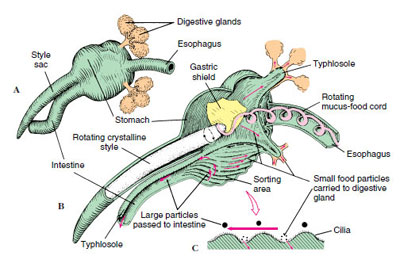
Barnegat Bay is home to several species of crabs, but the Blue crab is the most common and sought after.
Crabs Crustaceans
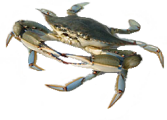 Crabs are classified in the phylum Arthropoda.
Crabs are classified in the phylum Arthropoda.
This is the same phylum as insects and spiders, however crabs are in the subphylum Crustacea (crustaceans) along with lobsters, shrimp, crayfish and barnacles.
They are called “decapods“, meaning they have 10 legs. The front pair is modified with strong claws and in some species the rear pair is modified for swimming.
Atlantic Blue Crab Callinectes sapidus Swimming crab
 The Blue Crab (often called Blue Claw Crab) is one of the most important commercial and recreational species in New Jersey.
The Blue Crab (often called Blue Claw Crab) is one of the most important commercial and recreational species in New Jersey.
Blue Crabs are found from Nova Scotia to northern Argentina, but are most abundant from Massachusetts on down and around the coast to Texas.
The blue crab’s abundance, beautiful coloration (a brilliant blend of olive-green, blue and red), aggressive temperament and delicious flavor make it a favorite of recreational crabbers in New Jersey
Although most small boats are ideal for reaching crabbing areas, almost any bank, bulkhead, bridge or pier bordering tidal waters can provide excellent crabbing.
Black-Fingered Mud Crab Panoeius herbstii Walking crab
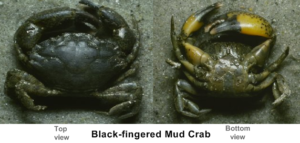 Though little known, the black-fingered mud crab is the most numerous of the non-swimming crabs in the bay.
Though little known, the black-fingered mud crab is the most numerous of the non-swimming crabs in the bay.
These crab grow to be about an inch and a half in size.
The black-fingered mud crab is a tiny, grayish-brown crab with powerful, black-tipped claws, one bigger than the other.
 The larger claw, called the major claw, has a large tooth on the movable “finger” of the claw.
The larger claw, called the major claw, has a large tooth on the movable “finger” of the claw.
The mud crab’s carapace, or shell, is wider than it is long, with five “marginal teeth.”
Like all crabs, they breathe oxygen through gills. These crabs live completely under water, unlike other species of semi-terrestrial crabs such as the fiddler crab
Mud crabs range from the salty mouth of the Bay up to moderately brackish waters.
These mud crabs are found on and around rocks, mud flats, pilings, oyster reefs, grass beds and sponge colonies near the shore. They sometimes create burrows under shells and stones.
They primarily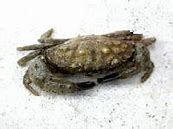 feed on other small invertebrates, such as worms, clams and other crabs. They use their strong claws to crush the shells of young clams and oysters, barnacles, periwinkles and other shellfish.
feed on other small invertebrates, such as worms, clams and other crabs. They use their strong claws to crush the shells of young clams and oysters, barnacles, periwinkles and other shellfish.
They will also feed on hermit crabs by seizing a hermit crab’s protruding legs and pulling it from its shell. marginal
Fun Fact – Black-fingered mud crabs are commonly found living inside cans, bottles, and other trash discarded by humans. The debris offers the little crabs protection.
This is a reflection of how animals have learned to adapt to an ever-increasing human impact
Green Crab Carcinus maenas Walking crab
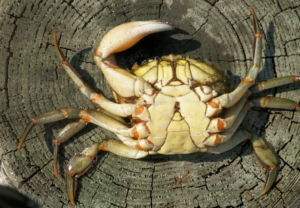
 Green crabs have dark green coloration on their carapace with numerous darker blotches. They possess flattened -walking legs on the last set of segments, and not paddles (like the blue crab).
Green crabs have dark green coloration on their carapace with numerous darker blotches. They possess flattened -walking legs on the last set of segments, and not paddles (like the blue crab).
They have more compact claws for crushing their prey.
Mature male crabs sometimes are yellow on their underside, while mature females are reddish-orange.
Green crabs are an introduced species to the area. They generally inhabit the colder waters within the intertidal zones of New England and south to New Jersey.
Green crabs are found in nearshore and estuarine waters. They tend to prefer higher salinity waters, usually near inlets by salt marshes.
The mature males grow to about 3 inches and females to 5 inches. They feed on small invertebrates, including snails.
Fun Fact – Green crabs are by far the most common species of crab used as bait for tautog Tautoga onitis (also known as blackfish).
Atlantic Rock Crab Cancer irroratus Walking crab
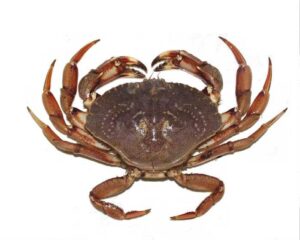 Rock crabs like most other crabs are decapods and are walking crabs
Rock crabs like most other crabs are decapods and are walking crabs
They live in the benthic zone (bottom) of the bay and ocean with the ability to adapt to extreme variations in depth.
Rock crabs are extremely mobile and as a scavenger, do not remain in one spot for very long. Each season they move between varying depths.
In autumn, which is their season of reproduction, most rock crabs remain at shallow depths. They tend to bury themselves in rocky areas, in tide pools and wander into lagoons.
Fun Fact – The rock crab has the nickname “Peekytoe” (learn more)
Jonah Crab Cancer borealis Walking crab
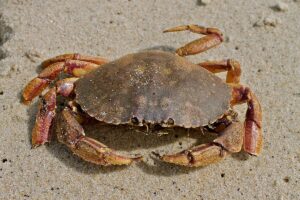 The Jonah crab inhabits waters along the east coast of North America from Newfoundland to Florida.
The Jonah crab inhabits waters along the east coast of North America from Newfoundland to Florida.
Jonah crabs have a rounded, , rough-edged carapace with small light spots, and robust claws with dark brown-black tips.er blotches. They have flattened walking legs on the last set of segments.
Jonah crabs have long been caught as bycatch in lobster traps. Once, they were considered a nuisance and a pest that stole the bait in the traps and they were thrown back in the sea by many an angry fishermen. Recently, particularly in New England, landings have increased due to increased fishing pressure and market demand.
Rock crabs and Jonah crabs are very similar in appearance.
Rock crabs are common in the bay and lagoons. Jonah crabs prefer deep water.
Crabbers often misidentify rock crabs as jonah crab.
(learn more)
Common Spider Crab Libinia emarginata Walking crab
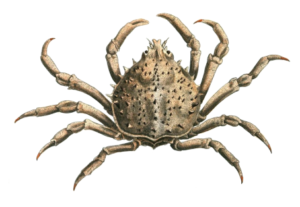 The common spider crab is also called the Atlantic spider crab or portly spider crab.
The common spider crab is also called the Atlantic spider crab or portly spider crab.
The shell (carapace) is spiny and covered with short hairs. The shell grows to 4 inches in diameter with a leg-span of twelve inches.
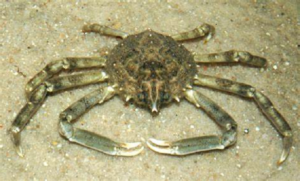
Like most other crabs , they are decapods.
Spider Crabs appear fearsome-looking but they are actually slow moving and harmless to humans.
Not particularly aggressive, the spider crab’s main defense against predators is camouflage. The hook-like hairs on the crab’s shell hold algae and other small debris in place. They can also burrow in soft sediment.
Spider crabs are omnivorous scavengers with diet consisting mainly algae and mollusks but almost anything else available on the bay floor including fish, sea stars, shrimp, and other crustaceans.
Fun Fact – different from most walking crabs, spider crab usually walk forward, although they are also capable of sidelong movement.
Lady Crab Ovalipes ocellatus Swimming crab
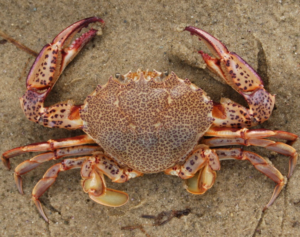 The Lady Crab is a brightly colored, aggressive, swimming crab with a collection of red and purple calico spots.
The Lady Crab is a brightly colored, aggressive, swimming crab with a collection of red and purple calico spots.
It is also known by some other names such as Leopard Crab and Ocellate crab.
The crab is named Lady (both male and female) mainly because of the beautiful color patterns on the shell
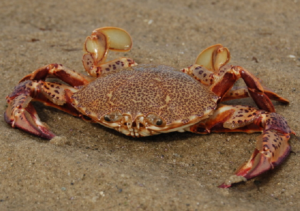
Like most other crabs, they are scavengers, eating both dead and live fish, crabs and other invertebrates.
Lady crabs often bury themselves leaving just its eyes and antennae expose.
The markings serve as a camouflage both to defend against predators and to help them ambush their prey.
Chinese Mitten Crab Eriocheir sinensis
 The Chinese mitten crab is a burrowing crab whose native distribution is the coastal rivers and estuaries of the Yellow Sea in Korea and China.
The Chinese mitten crab is a burrowing crab whose native distribution is the coastal rivers and estuaries of the Yellow Sea in Korea and China.
The main identifying features of the mitten crab are the dense patches of hairs on the white-tipped claws of larger juveniles and adults, hence the name mitten crab.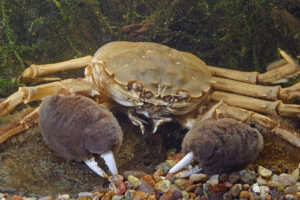
The claws are equal in size, the shell (carapace) has four spines on either side, and reaches a width of approximately 3 inches.
The Chinese Mitten Crab occurs in both freshwater and saltwater.
Young crabs spend two to five years in freshwater tributaries and can extend many miles upstream of bays and estuaries.
Mature male and female crabs migrate downstream to mate and spawn in saltwater estuaries.
They burrow into banks along estuaries and are able to leave the water to walk around obstacles while migrating.
Mole Crabs and Sand Crabs Family: Hippidae
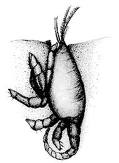 Mole crabs also known as sand crabs, while not common in the bay, are found on Island Beach and Long Beach Island living in the turmoil of breaking waves.
Mole crabs also known as sand crabs, while not common in the bay, are found on Island Beach and Long Beach Island living in the turmoil of breaking waves.
They move up and down the tide line to feed in the swash zone. The crabs burrow backward into the sand and face seaward, with only their eyes and first antennae showing.
As a receding wave flows over them, the sand crabs uncoil a second pair of featherlike antennae and sweep them through the water to filter out tiny plankton.
Fun Fact – Mole Crabs are commonly referred to as Sand Crabs, they are also called Sand Fleas, Beach Fleas, Sand Bugs, and Beach Hopper (to name a few).
Hermit Crabs
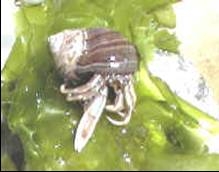 Hermit Crabs are not true crabs, but are an intermediate form having a soft shrimp-like tail that is protected inside the snail shell. (like all crabs, they are decapods)
Hermit Crabs are not true crabs, but are an intermediate form having a soft shrimp-like tail that is protected inside the snail shell. (like all crabs, they are decapods)
Unlike other crabs, the hermit crab has no exoskeleton, so for protection, it forces its vulnerable body into the curved chamber of an empty gastropod shell (or similar object) for protection.
Credits
